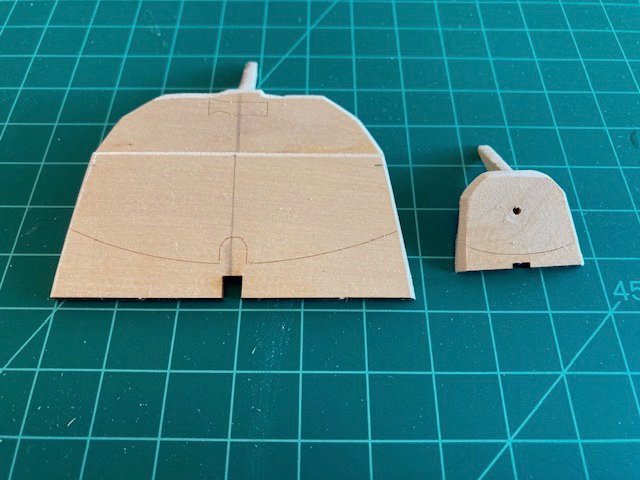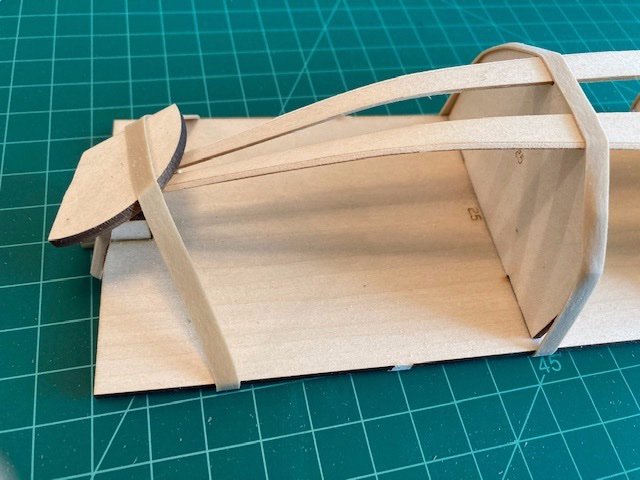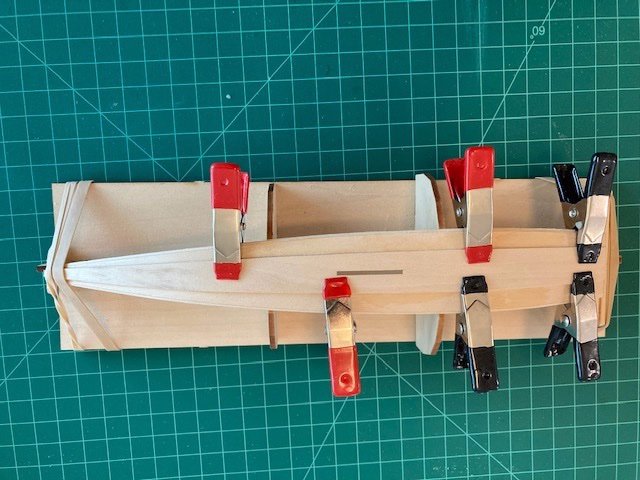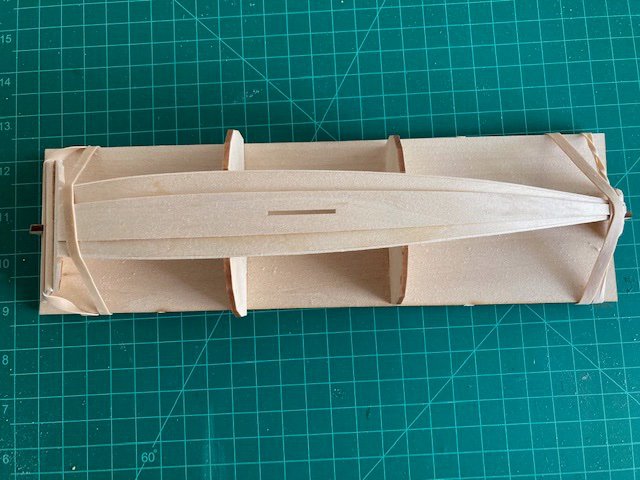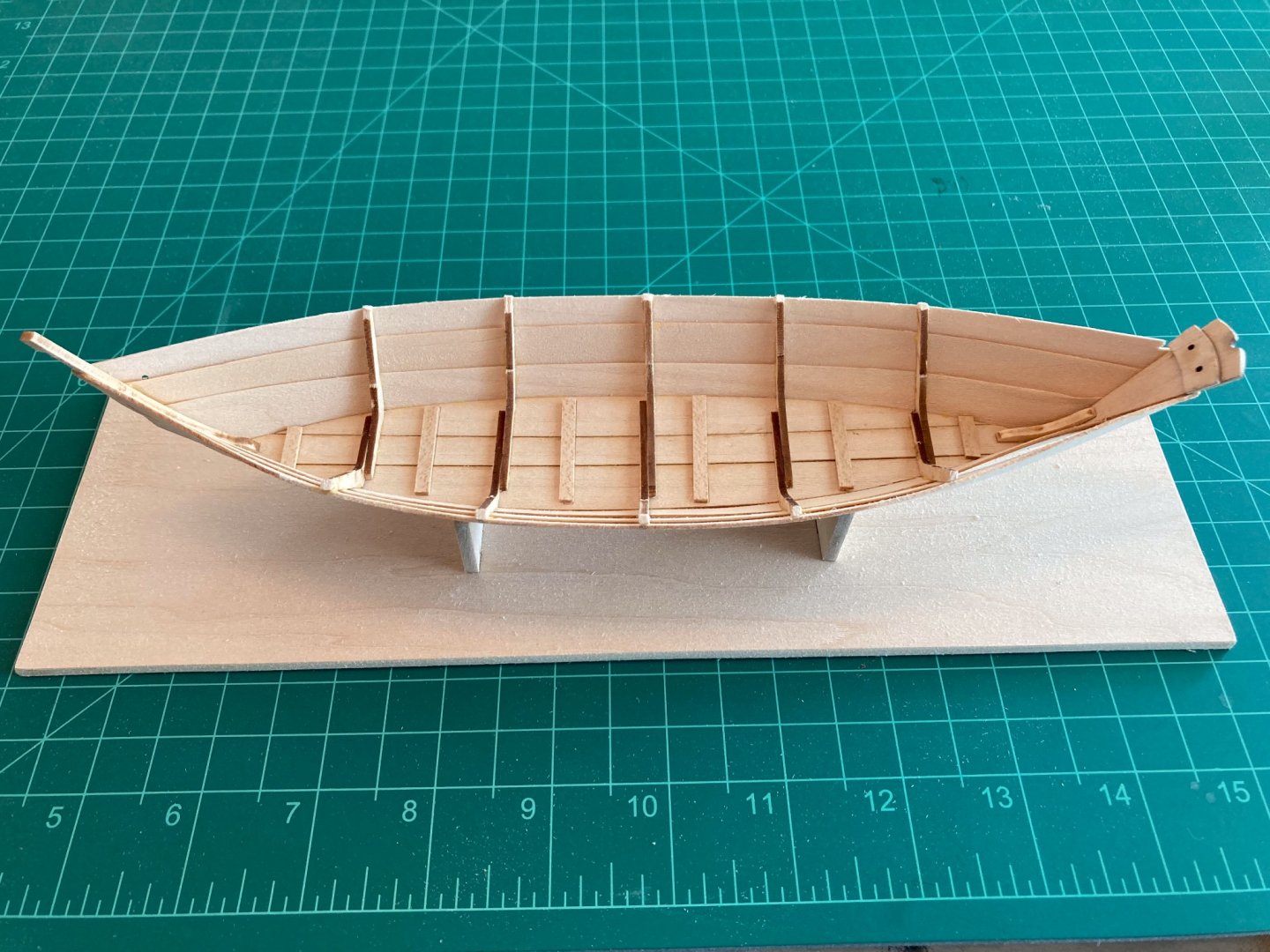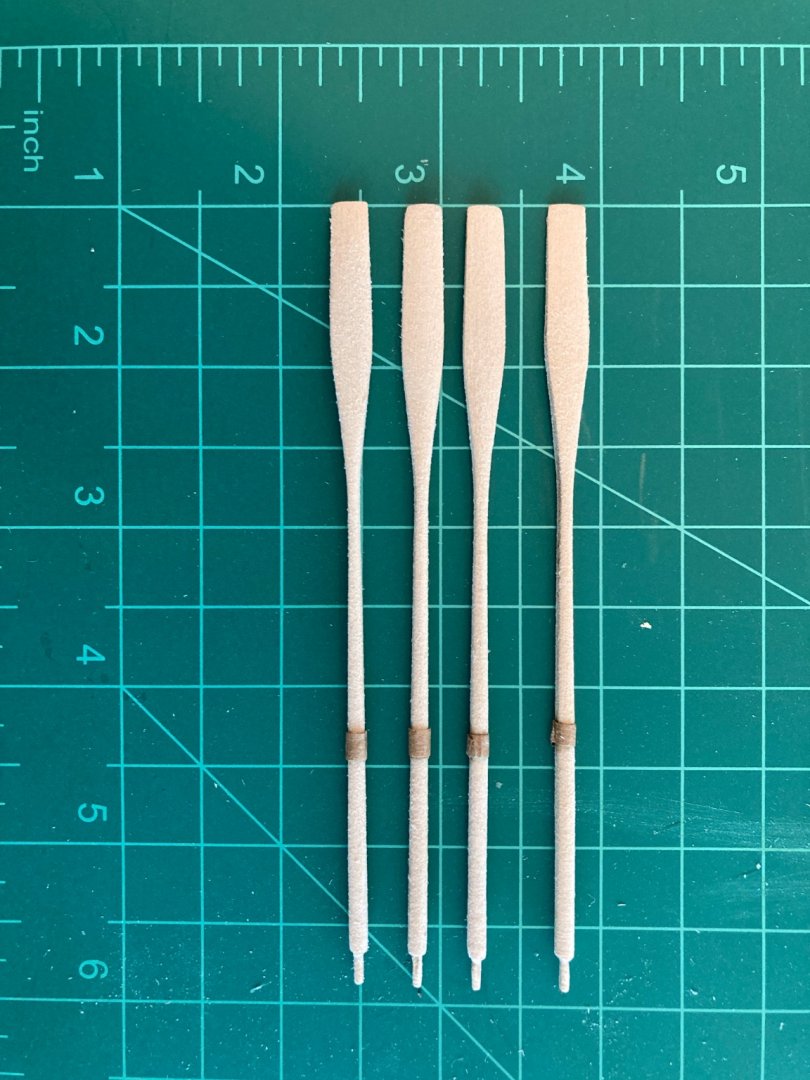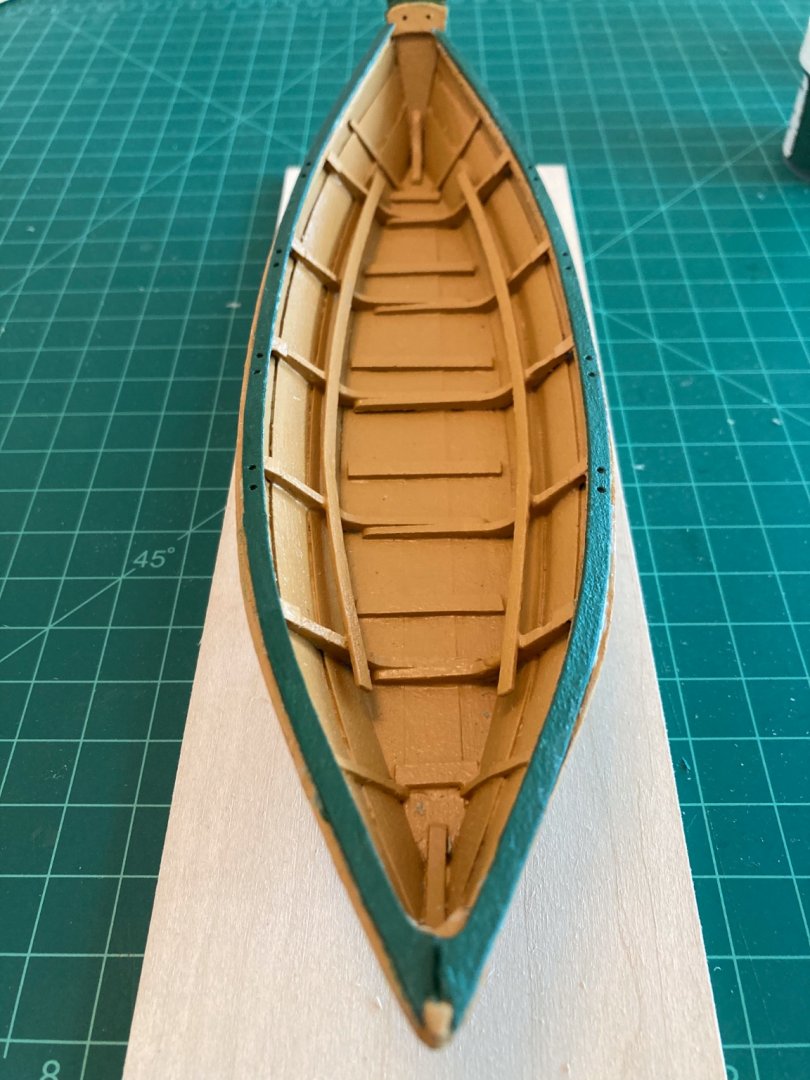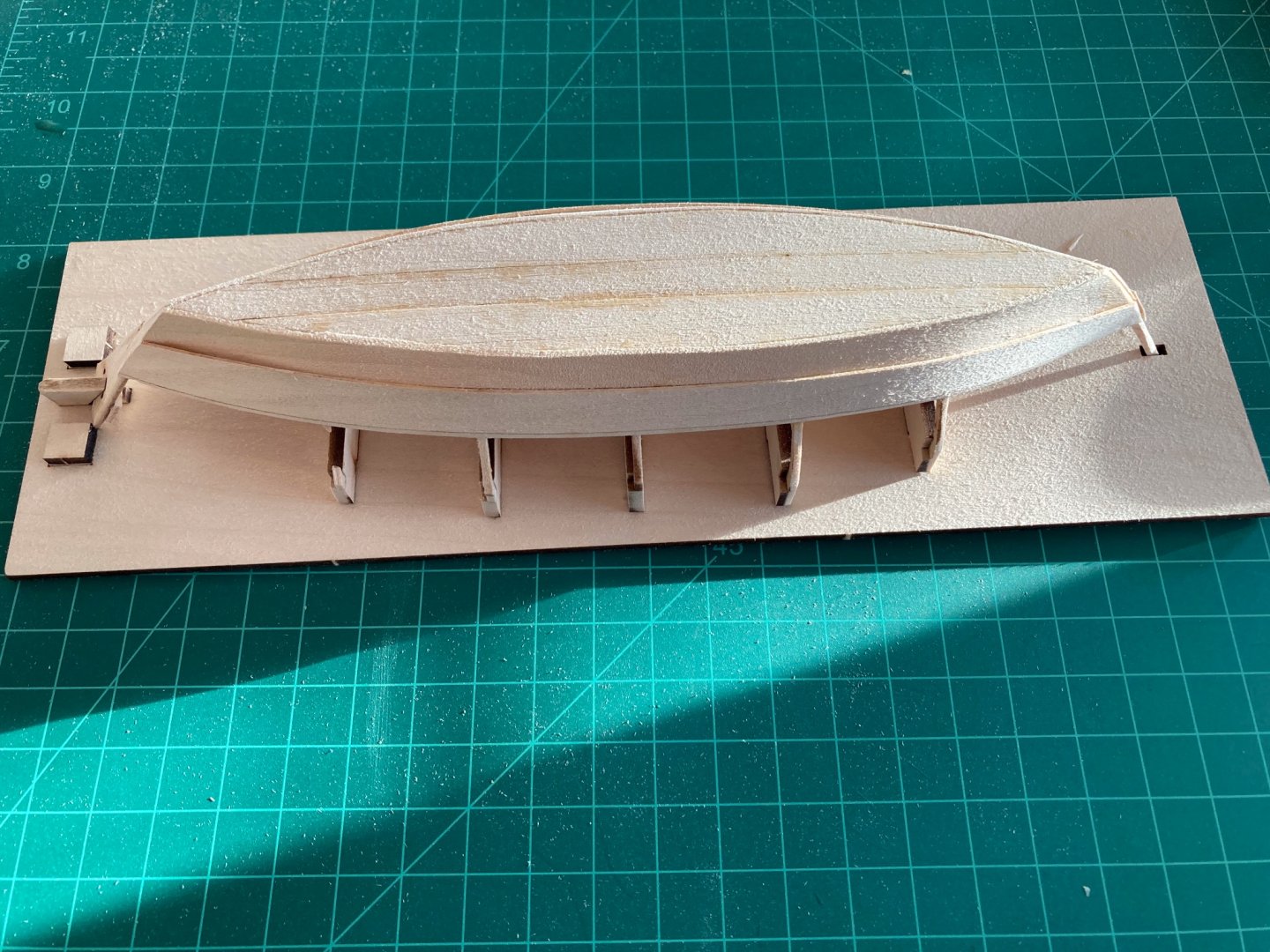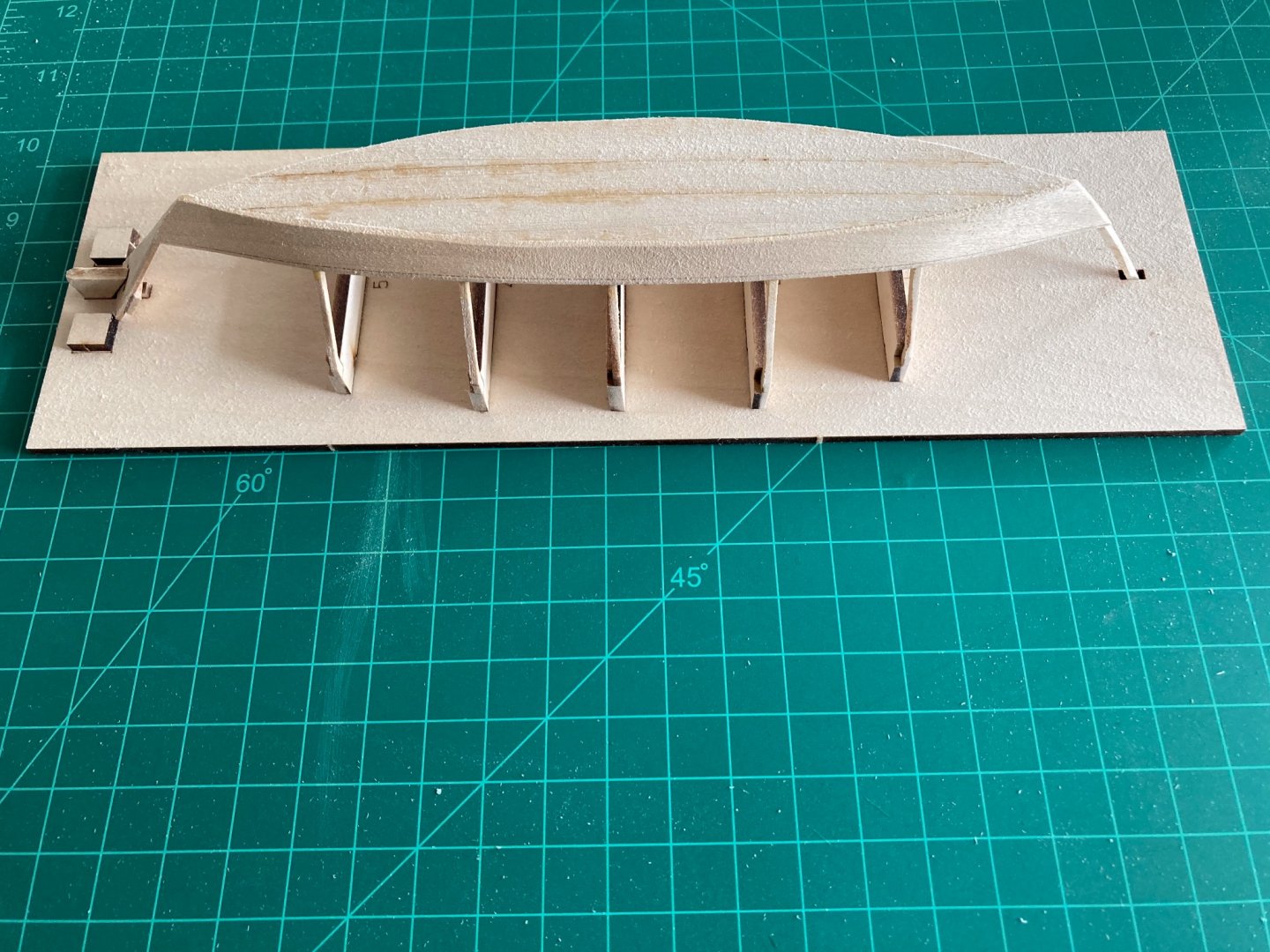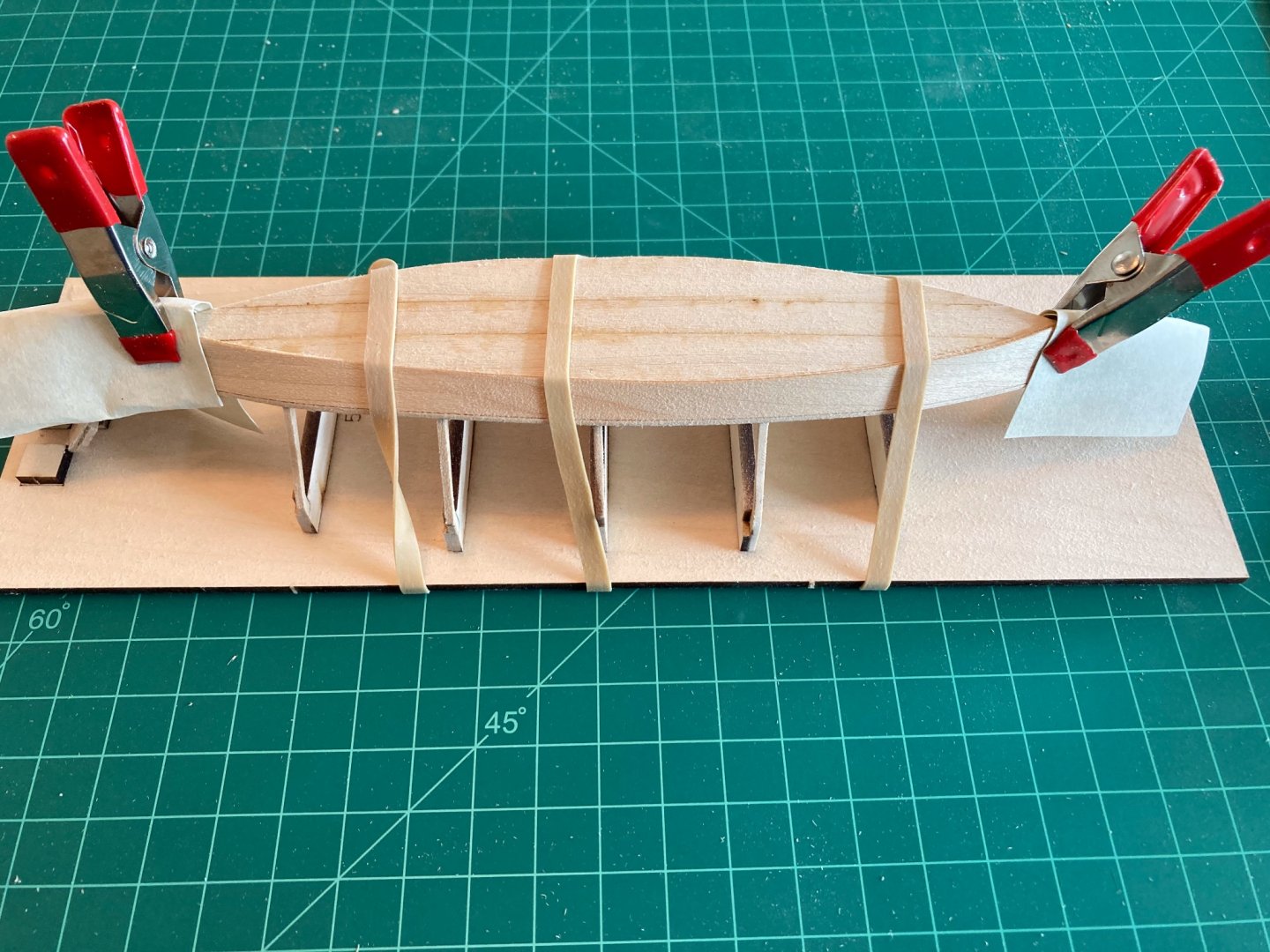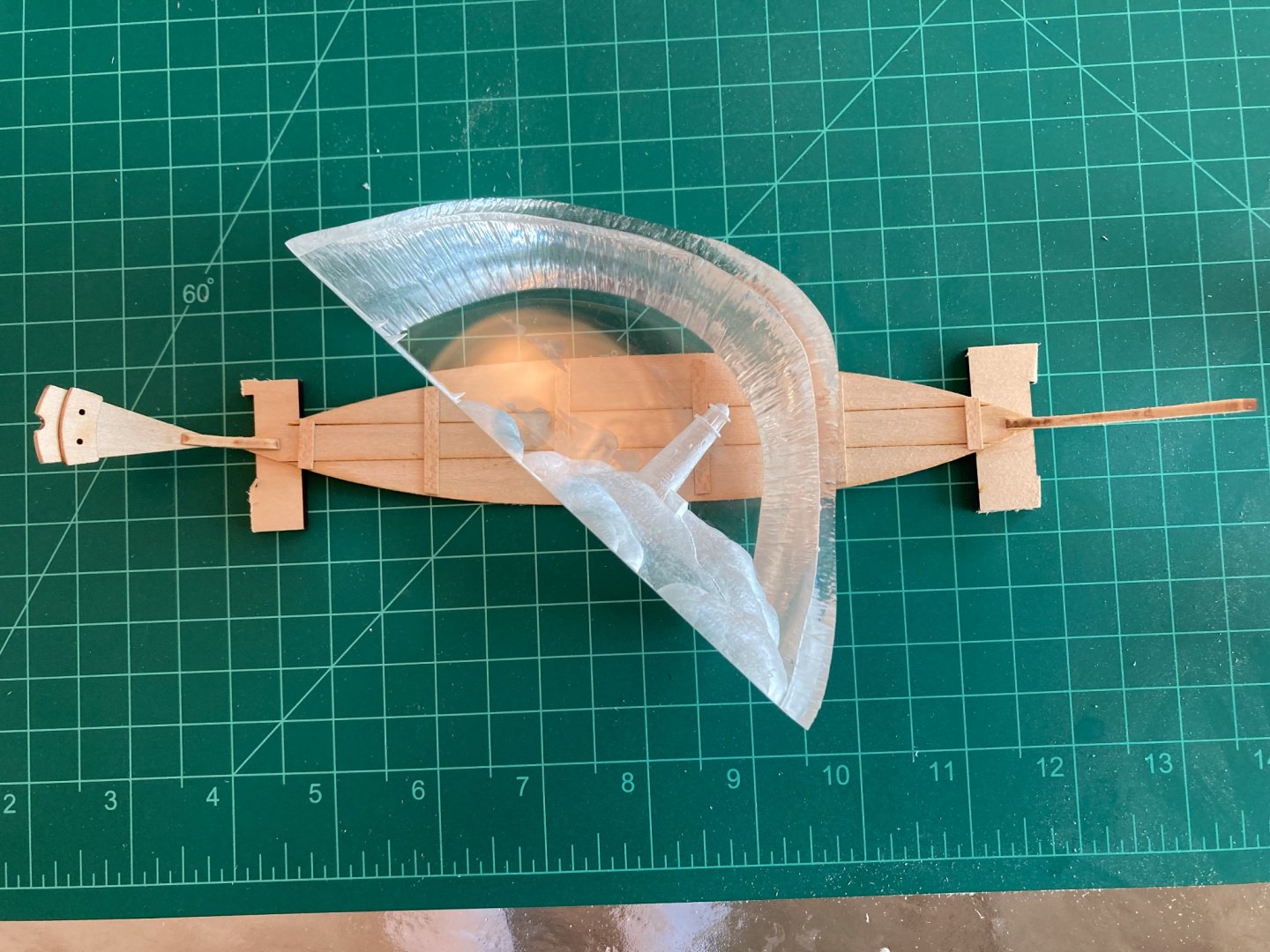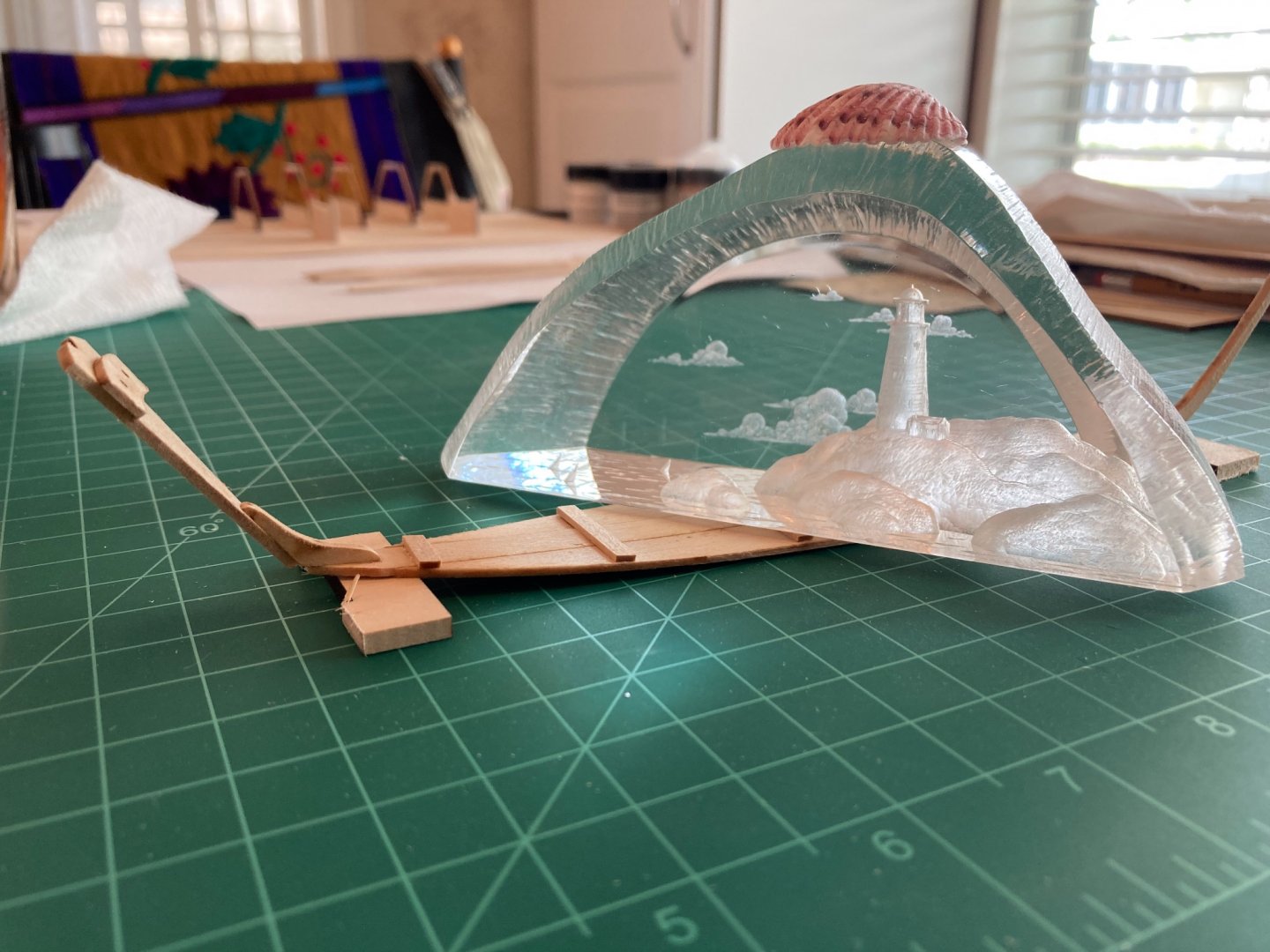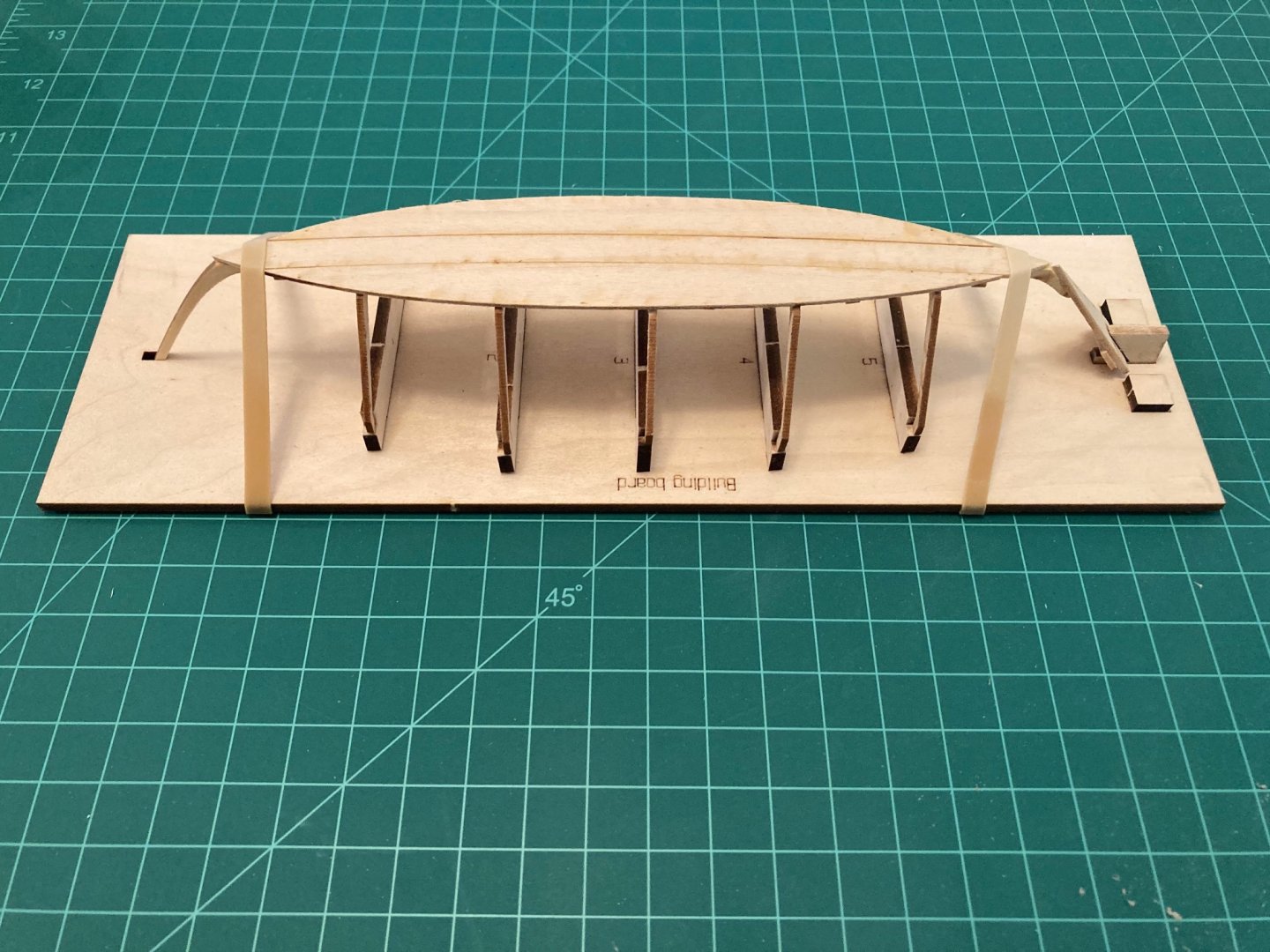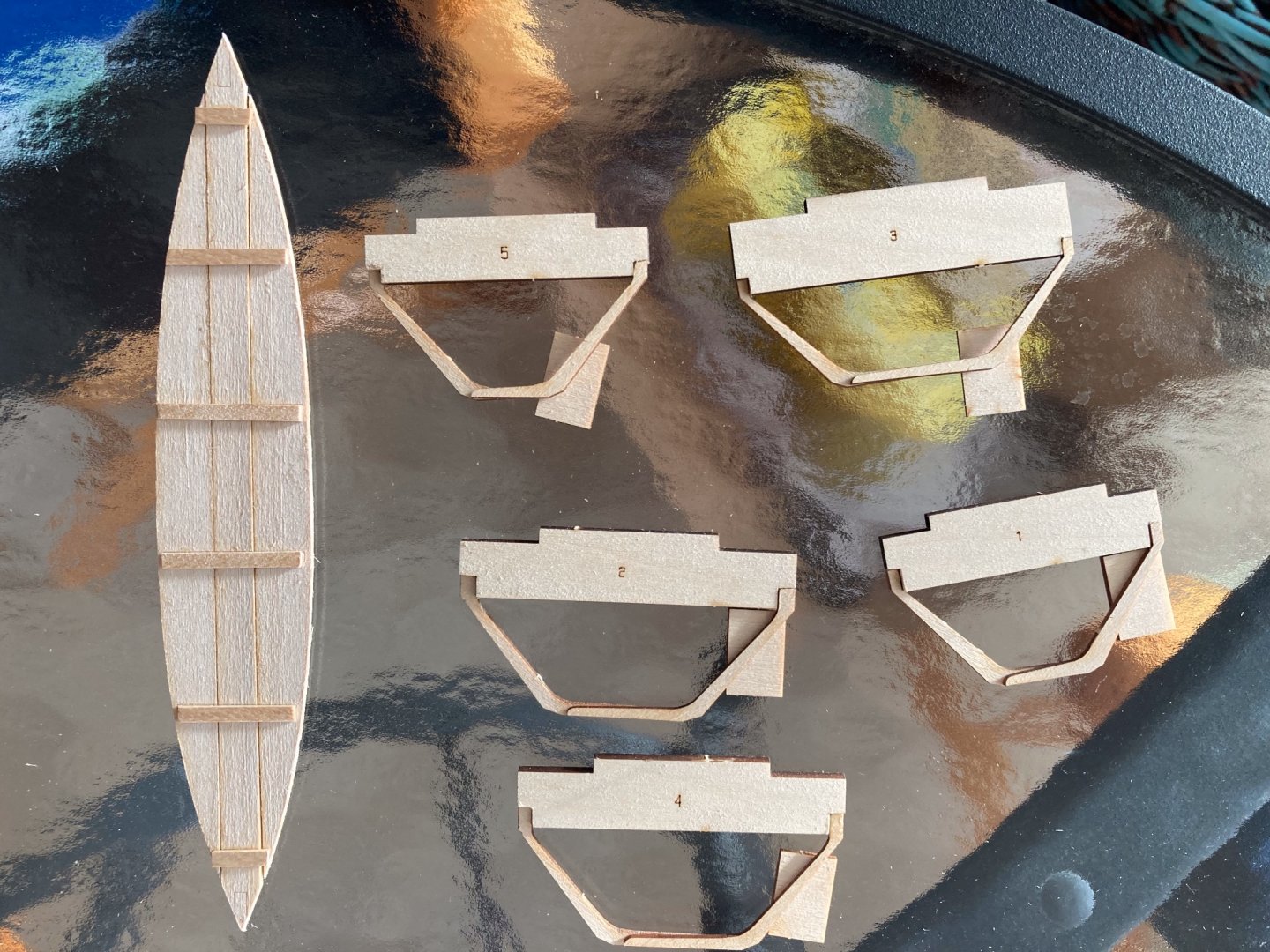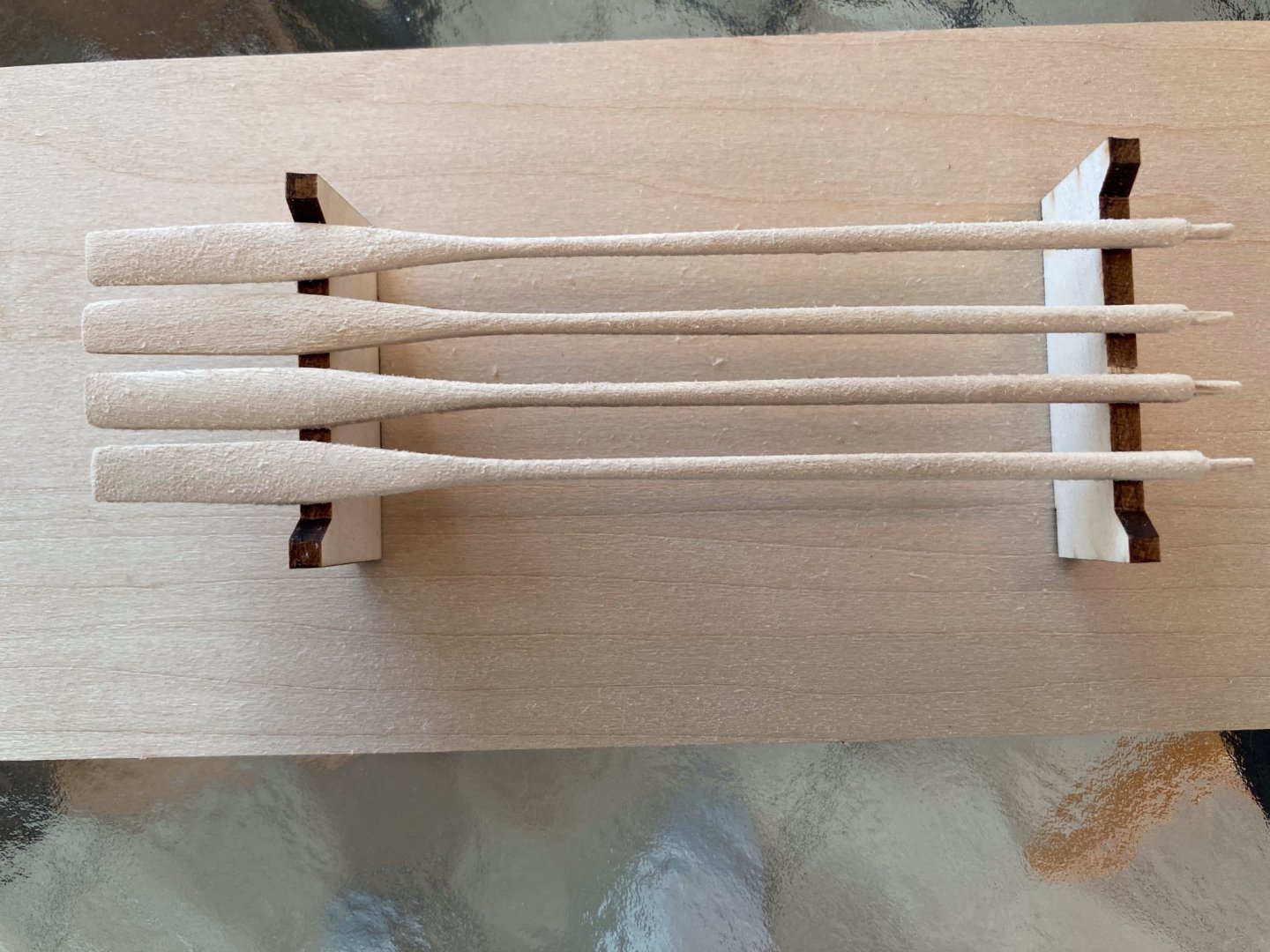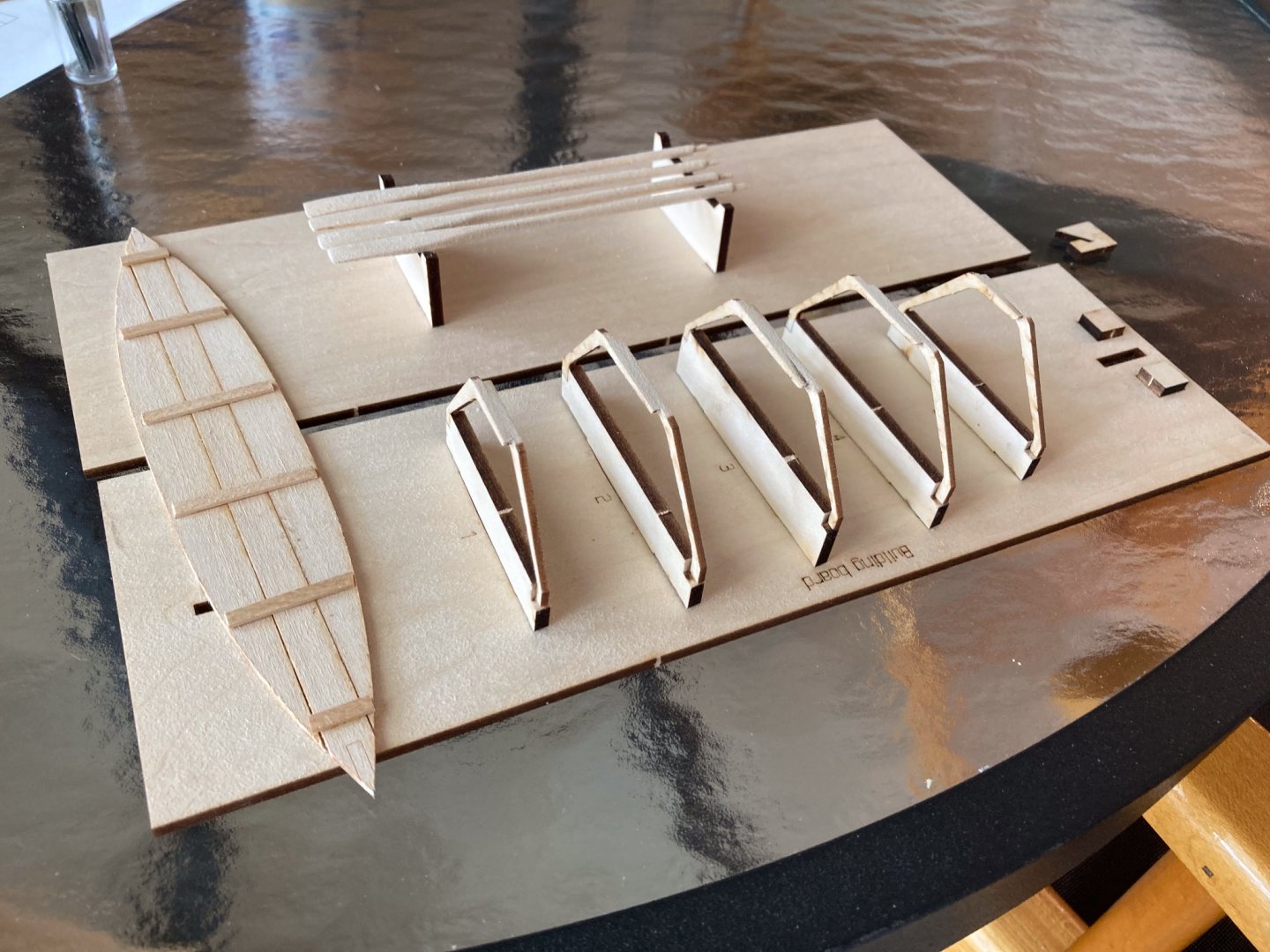
DPhilbrick
Members-
Posts
26 -
Joined
-
Last visited
Content Type
Profiles
Forums
Gallery
Events
Everything posted by DPhilbrick
-
I'm underway. I worked on the transoms first. After setting the stern knee to the transom I realized it was not quite centered, so I applied some alcohol to the joint and after cleaning it up, re-glued it in its proper position. Once the transoms were both properly beveled, I set up the build board. I had problems with the bow transom support; it broke and had to be glued back together. Once that was set up I sanded the char on the keel and bottom planks, beveled the bottom planks and after soaking them in hot water, bent them to shape. I wrapped the build board molds with rubber bands and slid the planks underneath the bands to hold them in place as I glued them together at to the bow transom. Once that was set, I glued them to the stern transom. There was overlap, but waited until the keel plank was glued down before trimming them at the stern. I was afraid I would break things if I tried to saw the overlap, so I took my time and sanded them down until they were flush with the transom. Ditto on the bow. So far, so good.
-
I finished putting on the sheer plank and freed the hull. I put on the false stem, seat risers and bands and sanded the tops of the sheer strakes and bands. After cutting back the tops of the frames I put in the gunwale. I made up some frame head irons out of pieces of file folder. Once that was finished, I sprayed the whole hull down with gray primer before painting three coats of Model Expo's Hull Yellow Ochre, allowing each coat to dry before moving on to the next coat. After painting the cap rail with Bulwarks Dark Green, and allowing it to dry, I started mounting the cap rail, which was tough as I was initially a bit impatient. I had to slow down, glue a short piece at a time and then let it totally set. I leathered the oars with brown paper and am now trying to locate some rope that will work in the small holes. It's far from perfect, but I'm satisfied with what I've learned. A few more steps before I'm done.
-
As I was putting on the broad planks I saw that the garboards were pinched in just before they came to the transom leaving gaps between the garboards and the broad planks. I think there was too much pressure on them when the clamps were holding them in place as they dried. Reading Steve's build, I think I can put water on them and "bend" them back into shape once I release the dory from the build board. If not, I'll use some filler made from my saved cup of sanding. Also, when I was gluing the port broad plank I put too much pressure on the #5 frame and it cracked and ultimately broke off where it hits the broad plank. I saved the part and will glue that back in place when the dory is freed. It's all a learning experience, so I move on, a bit scarred, but undaunted.
-
LOWELL’S GRAND BANKS DORY (From Lowellsboatshop.com) In 1897, the Amesbury Daily News reported that “When the manufacture of fishing dories for the Banks trade grew up, Mr. [Hiram] Lowell was one of the pioneers.“ John Gardner and other historians have suggested that Hiram Lowell “invented” the American Grand Banks dory by modifying the round sided wherry and colonial flat-bottomed “batteaux” made by Simeon Lowell and others before 1830. There is additional evidence, which suggests that the name, form and use of the dory derived as well from French fishermen, who used similar boats for Grand Banks fishing. By 1860, Hiram Lowell modified his family boat building business to produce fishing dories on a large scale. By the last quarter of the 19th century, Hiram Lowell’s boat shop became the leading manufacturer of dories in the United States. Lowell dories had a reputation for quality and were popular in Gloucester. Howard Blackburn, the most famous Gloucester dory fisherman who survived a winter storm off Newfoundland in 1881 owed his life to the integrity and design of an 18-foot Lowell dory. During the 1890s Lowell dories were delivered “primarily to Gloucester” and a fishing schooner named after the great dory maker, Hiram Lowell, was built in Gloucester in 1892. IN 1984, the 92-year-old Gloucester schooner captain Morton Seilig recalled: “We in Gloucester used Lowell dories. Wouldn’t use anything else. They were the best. If you had a Lowell dory, you had a good dory.” Dory quality was critical to the men whose lives depended on them, and Lowell dories were chosen by many Gloucester fishermen. Lowell dories became a standard fixture on Gloucester schooners and Gloucester beaches by the third quarter of the 19th century, valued both as a deep-sea vessel for use with schooners, and as a row boat for Victorian outings and recreation. American artist Winslow Homer recorded Gloucester dories in many of his marine renderings of the 1870s and 1880s. Paintings and engravings such as Waiting for Dad (1873), Gloucester Harbor (1873), Three Boys in a Dory with Lobster Pots (1875), Children Playing under a Gloucester Wharf (1880), Green Dory (1880), and the Fog Warning (1885) attest to the vessel’s popularity as both a hard-working commercial boat, and a recreational boat for children and mothers in Victorian Gloucester. By the 1890’s, the Gloucester fisherman and Gloucester dory were further popularized by Rudyard Kipling in the classic sea documentary, Captains Courageous. The Lowell dory was popular in other areas besides Gloucester. The Moultons are known to have delivered Lowell dories north to Portsmouth, New Hampshire. The Coast Guard in nearby Newburyport purchased Lowell dories to use as surf rescue craft. The famous Swampscott dories are also believed to have derived in part from Lowell originals. Lowell dories and boats were sent to destinations across the United States and Europe. In the early 20th century, arctic explorer Donald MacMilan witnessed a Lowell dory being used by Eskimos in the far north.
-
Steve, the statement was not meant to be a generalization, rather my own understanding of my strengths and weaknesses. My father was a professional chef, a professional carpenter and welder. I picked up the cooking, but not working with my hands. I ended up as a professional musician while my dad said he played two instruments: the radio and the cash register. As Dirty Harry said, "A man needs to know his limitations." Still, I admire greatly admire artistry when I see it and am enjoying the process. Thanks for the tips. The port garboard is glued and sanded. On to the starboard.
-
Thanks for the likes and advice. It's a work in process. I will never achieve the amazing level of craftsmanship I've seen on the site, but I'm enjoying the peace I experience as I work with the wood. This morning I sanded a beveled edge on the garboards making sure the ends had a rolling bevel. My initial instinct was to set the "stahbad gahbad" (I couldn't resist this as it popped into my head thinking back on my youth on the Cape), but ended up soaking the port garboard and set it on the frames with clamps and rubber bands. I'll let it dry overnight and glue it down in the morning.
-
Well the missing stem and stern cleat finally arrived. I cleaned them up and glued them to the bottom allowing them to dry overnight. This afternoon I wet the bottom of the bottom and set it on two 1/8" pieces of scrap wood to curve the bottom. I used an acrylic carving of a lighthouse for the weight in the middle that I got from Randy Rich. Randy is an amazing artist who uses dental tools to reverse-carve these scenes. He also has a thriving business carving trophies for big fishing tournaments around the country. It worked great. This evening I glued the bottom to the frames which I had previously sanded and set up in the building frame, remembering to press fit the frames, not glue them. I used a couple of elastic bands to hold the bottom to the frames after they were glued down. Next up...preparing the planking.
-
You never know what will pop up when you start digging. My dad's sister was desperate to get into the Daughters of the American Revolution but couldn't find anyone who actually fought...the best she could do was a Quaker who gave out water to the guys on the Concord Green that day. Hey, someone has to supply the troops.
-
No relation to Nathaniel that I know of although many of the New England Philbricks dropped in the Boston area and some went up to New Hampshire. Our line came over in the mid-1600s and one in the family tree was the youngest member of the group of malcontents who pulled off the Boston Tea Party. Dad explained the family motto, "Don't look back" by saying the Philbricks were a bunch of horse thieves and when you are riding off on someone else's horse it's not a good idea to look back. It just might have been some wishing they had never left England, though I'm glad they did.
-
Congratulations and great job!
- 11 replies
-
- Lowell Grand Banks Dory
- Model Shipways
-
(and 2 more)
Tagged with:
-
Overwhelmed, under-tooled, but undaunted, I have started my first model, Model Shipways, Lowell Grand Banks Dory. I completed the bottom and then discovered the sheet with the stem, transom and stern knee were missing. I contacted Model Expo and have been waiting for the parts to continue that piece of the project. While waiting I have worked on the oars, set the frames and beveled them with a sanding stick I put together with one of the leftover basswood strips and 150 sandpaper. I believe the missing pieces are on the way. It's been fun.
-
Wow! This has been amazing, a bit overwhelming and somewhat intimidating. A few weeks ago I decided I wanted to start a new hobby and as I grew up on Cape Cod in the 50s and 60s and have always loved sailing, decided to try my hand at building model ships. I found Model Expo and knowing I know nothing, decided to start with the three from David Antscherl, Lowell Grand Banks Dory, Norwegian Pram and Muscongus Bay Lobster Smack. I started work on the Dory and then discovered a missing sheet of basswood that has stalled the build for a couple of weeks as I wait for them to send it. While waiting for that, I discovered Model Ship World and have been blown away with the amazing work and dedication I've seen in so many wonderful builds. I also found Blue Jacket Shipcrafters and have a Swampscott Dory coming from them. Through years of playing golf and flute I have developed a lot of patience (not one of the virtues I was born with) and an understanding that not every shot is a great one (so relax) and to achieve excellence in any skill or craft takes time and effort and the opportunity to watch others do what you are hoping to do yourself. I look forward to exploring more of your builds and most of all, enjoying the journey. Regards David
About us
Modelshipworld - Advancing Ship Modeling through Research
SSL Secured
Your security is important for us so this Website is SSL-Secured
NRG Mailing Address
Nautical Research Guild
237 South Lincoln Street
Westmont IL, 60559-1917
Model Ship World ® and the MSW logo are Registered Trademarks, and belong to the Nautical Research Guild (United States Patent and Trademark Office: No. 6,929,264 & No. 6,929,274, registered Dec. 20, 2022)
Helpful Links
About the NRG
If you enjoy building ship models that are historically accurate as well as beautiful, then The Nautical Research Guild (NRG) is just right for you.
The Guild is a non-profit educational organization whose mission is to “Advance Ship Modeling Through Research”. We provide support to our members in their efforts to raise the quality of their model ships.
The Nautical Research Guild has published our world-renowned quarterly magazine, The Nautical Research Journal, since 1955. The pages of the Journal are full of articles by accomplished ship modelers who show you how they create those exquisite details on their models, and by maritime historians who show you the correct details to build. The Journal is available in both print and digital editions. Go to the NRG web site (www.thenrg.org) to download a complimentary digital copy of the Journal. The NRG also publishes plan sets, books and compilations of back issues of the Journal and the former Ships in Scale and Model Ship Builder magazines.


